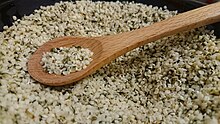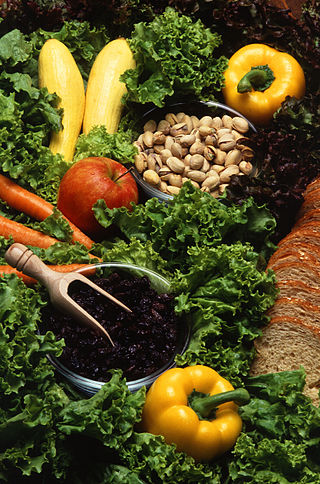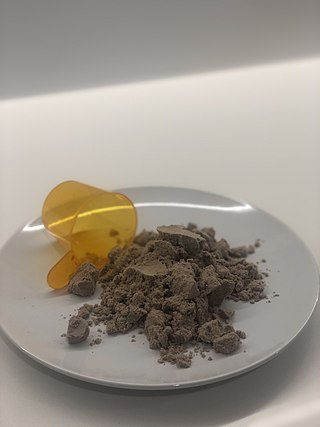
Hemp protein is a plant-derived protein from the cannabis plant and is isolated from hemp seeds (a type of nut). [1] [2]

Hemp protein is a plant-derived protein from the cannabis plant and is isolated from hemp seeds (a type of nut). [1] [2]
The protein content of whole hemp seeds can vary between 20 and 25% depending on variety and environmental factors. [3] [2] Processing methods such as dehulling or oil fraction removal can increase the protein concentration in products like dehulled seed or hemp seed meal to over 50%. [3] [4]
Hemp seeds are comparable with soybeans in terms of nutrition. [4] They are high in protein, low in carbohydrates, and rich in dietary fiber and unsaturated fatty acids. After the oil is extracted from the hemp seeds, the residual mass is a protein-rich material useful for food processing. [3] [4]
The protein in hemp seeds is made up of the two highly digestible globular types of proteins, edestin (60–80%) and 2S albumin, [5] with edestin also being rich in the essential amino acids. [2] [6] [7] [8]
Hemp protein is rich in essential amino acids, containing, in sufficient quantities, all essential amino acids required by humans except lysine, which appears at lower than recommended levels for infants aged up to five years old according to Food and agricultural organization (FOA) standards; still, the overall nutritive value of hemp protein remains relatively good, as sulfur-containing amino acids are higher than in casein or soy, while other non-essential amino acids present in hemp protein, such as arginine, provide additional health benefits including cardiovascular support, immune function optimization, and muscle repair. [3]
Hemp protein has unique properties that are useful in food processing. Its cysteine-rich amino acid composition and high sulfhydryl (-SH)/disulfide (S-S) ratio offer a glimpse of its distinctive features. [9] [4] These features can facilitate the development of new food materials. [4]

Hemp protein, when untreated, is more digestible compared to soy protein. Heat pre-treatment at temperatures above 80°C may improve the digestibility of both hemp and soy protein, but in untreated (unheated) form hemp protein is more readily digested than the soy one. [3]
Dehulled hemp seeds (also known as hemp nuts, hemp kernels or hemp hearts) have a protein digestibility corrected amino acid score (PDCAAS) of 0.66, with lysine being the limiting amino acid (digestibility of 92.1%). [3] [10]
With its gluten content as low as 4.78 ppm, hemp is attracting attention as a gluten-free (<20 ppm) food material. [4] [9]
Hemp protein is sold in bulk as a powder, in various forms, such as hempseed meal, hemp protein concentrates, and hemp protein isolates. It generally has greenish hue due to the natural pigments in the hemp plant, but the color can vary depending on the specific processing methods used. Unflavored hemp protein powder is commonly available, that is, no additionall flavoring is added to the hemp protein, which is usually described as earthy or nutty. [11] [12] [9] [13] [14]
Observations of limiting enzymatic hydrolysis elicited by trypsin in a controlled environment have shown an increase in hemp protein isolate (HSI) solubility at various pH and a notable decrease in the recorded emulsifying activity index. [3] [15]
Hemp protein is gaining attention in the context of its environment benefit. Hemp is reevaluated as a promising crop in the era of sustainable development goals (SDG) due to its sustainable growth characteristics and versatile industrial usability. [4] [9]
The entire hemp plant—its leaves, stalks, roots, and seeds—can be used, reducing waste. The stalk is used for fiber production, the leaves/roots for medicine, and seeds for oil and protein. [9] [4] Hemp has a short cropping period and requires less pesticide or water compared to cotton, a representative fiber material and food plant, that makes hemp a sustainable choice for cultivation. [4]

The soybean, soy bean, or soya bean is a species of legume native to East Asia, widely grown for its edible bean, which has numerous uses.

Hemp oil is oil obtained by pressing hemp seeds. Cold pressed, unrefined hemp oil is dark to clear light green in color, with a nutty flavor. The darker the color, the grassier the flavour. It should not be confused with hash oil, a tetrahydrocannabinol-containing oil made from the Cannabis flower.

Hemp, or industrial hemp, is a plant in the botanical class of Cannabis sativa cultivars grown specifically for industrial and consumable use. It can be used to make a wide range of products. Along with bamboo, hemp is among the fastest growing plants on Earth. It was also one of the first plants to be spun into usable fiber 50,000 years ago. It can be refined into a variety of commercial items, including paper, rope, textiles, clothing, biodegradable plastics, paint, insulation, biofuel, food, and animal feed.

Cannabis sativa is an annual herbaceous flowering plant. The species was first classified by Carl Linnaeus in 1753. The specific epithet sativa means 'cultivated'. Indigenous to Eastern Asia, the plant is now of cosmopolitan distribution due to widespread cultivation. It has been cultivated throughout recorded history and used as a source of industrial fiber, seed oil, food, and medicine. It is also used as a recreation drug and for religious and spiritual purposes.

Vegetarian nutrition is the set of health-related challenges and advantages of vegetarian diets.
Protein digestibility-corrected amino acid score (PDCAAS) is a method of evaluating the quality of a protein based on both the amino acid requirements of humans and their ability to digest it.

A milk substitute is any substance that resembles milk and can be used in the same ways as milk. Such substances may be variously known as non-dairy beverage, nut milk, grain milk, legume milk, mock milk and alternative milk.

Leaf protein concentrate (LPC) refers to the proteinaceous mass extracted from leaves. It can be a lucrative source of low-cost and sustainable protein for food as well as feed applications. Although the proteinaceous extracts from leaves have been described as early as 1773 by Rouelle, large scale extraction and production of LPC was pioneered post the World War II. In fact, many innovations and advances made with regards to LPC production occurred in parallel to the Green Revolution. In some respects, these two technologies were complimentary in that the Green Revolution sought to increase agrarian productivity through increased crop yields via fertiliser use, mechanisation and genetically modified crops, while LPC offered the means to better utilise available agrarian resources through efficient protein extraction.

Proteins are essential nutrients for the human body. They are one of the building blocks of body tissue and can also serve as a fuel source. As a fuel, proteins provide as much energy density as carbohydrates: 4 kcal per gram; in contrast, lipids provide 9 kcal per gram. The most important aspect and defining characteristic of protein from a nutritional standpoint is its amino acid composition.

Soy protein is a protein that is isolated from soybean. It is made from soybean meal that has been dehulled and defatted. Dehulled and defatted soybeans are processed into three kinds of high protein commercial products: soy flour, concentrates, and isolates. Soy protein isolate has been used since 1959 in foods for its functional properties.

Cannabigerol (CBG) is one of more than 120 identified cannabinoid compounds found in the plant genus Cannabis. Cannabigerol is the decarboxylated form of cannabigerolic acid, the parent molecule from which other cannabinoids are synthesized.
Edestin, is a highly-digestible, hexameric legumin protein with six subunits, and a seed storage protein, with a molecular weight of 310 kDa. This protein is primarily found in hemp seeds. Edestin is a globular protein as opposed to fibrous protein (structural).

Pea protein is a food product and protein supplement derived and extracted from yellow and green split peas, Pisum sativum. It can be used as a dietary supplement to increase an individual's protein or other nutrient intake, or as a substitute for other food products. As a powder, it is used as an ingredient in food manufacturing, such as a thickener, foaming agent, or an emulsifier.

Hemp juice is a beverage derived from industrial hemp, made from the result of pressing the Cannabis sativa plant. The juice is obtained through a large-scale industrial cold-pressing procedure using the upper parts of the hemp plant as well as the leaves. This procedure distinguishes hemp juice from other hemp products such as hemp oil, hemp sprouts or hemp milk, which are obtained through the seeds of the hemp plant.
Protein quality is the digestibility and quantity of essential amino acids for providing the proteins in correct ratios for human consumption. There are various methods that rank the quality of different types of protein, some of which are outdated and no longer in use, or not considered as useful as they once were thought to be. The Protein Digestibility Corrected Amino Acid Score (PDCAAS), which was recommended by the Food and Agriculture Organization of the United Nations (FAO), became the industry standard in 1993. FAO has recently recommended the newer Digestible Indispensable Amino Acid Score (DIAAS) to supersede PDCAAS.
Digestible Indispensable Amino Acid Score (DIAAS) is a protein quality method proposed in March 2013 by the Food and Agriculture Organization to replace the current protein ranking standard, the Protein Digestibility Corrected Amino Acid Score (PDCAAS).

As in the human practice of veganism, vegan dog foods are those formulated with the exclusion of ingredients that contain or were processed with any part of an animal, or any animal byproduct. Vegan dog food may incorporate the use of fruits, vegetables, cereals, legumes including soya, nuts, vegetable oils, as well as any other non-animal based foods.
'FINOLA' is a low THC hemp variety from Finland that is primarily used to produce hempseed.
Cruciferin is one of the two most abundant seed storage proteins in mustard and rapeseed. They are classified as 11S globulins based on their sedimentation coefficient, and are salt soluble neutral glycoproteins. Their molecular weights range from 20 to 40 kDa. They comprise up to 50–70% of the total seed protein. Cruciferin is a comparatively larger seed storage protein than napin. It is composed of two polypeptide chains α and β. The α-chain has a mass of 30 kDa and the β-chain weighs in at 20 kDa. They are held together by a disulphide bond.

Cannabis (/ˈkænəbɪs/) is commonly known as marijuana or hemp and has two known strains: Cannabis sativa and Cannabis indica, both of which produce chemicals to deter herbivory. The chemical composition includes specialized terpenes and cannabinoids, mainly tetrahydrocannabinol (THC), and cannabidiol (CBD). These substances play a role in defending the plant from pathogens including insects, fungi, viruses and bacteria. THC and CBD are stored mostly in the trichomes of the plant, and can cause psychological and physical impairment in the user, via the endocannabinoid system and unique receptors. THC increases dopamine levels in the brain, which attributes to the euphoric and relaxed feelings cannabis provides. As THC is a secondary metabolite, it poses no known effects towards plant development, growth, and reproduction. However, some studies show secondary metabolites such as cannabinoids, flavonoids, and terpenes are used as defense mechanisms against biotic and abiotic environmental stressors.